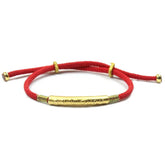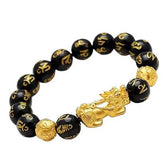How to Make Prayer Beads
Buddhist prayer beads, commonly referred to as malas, have been a cherished tool for meditation and prayer for many centuries. In this guide, we will provide you with a detailed, step-by-step approach to crafting your own mala beads, covering everything from selecting the appropriate materials to bestowing the final blessing.
Buddhist Beads Meaning
Buddhist beads, traditionally used in meditation, are a string of beads designed to count mantras or prayers. By using the beads to track repetitions, practitioners can concentrate fully on the mantra's meaning, fostering a deeper state of mindfulness.
Typically, a mala consists of 108 beads, symbolizing the 108 human passions that must be overcome to achieve enlightenment. These beads can be crafted from various materials, each carrying its own symbolic meaning and spiritual significance. Many believe that Buddhist beads offer protection and positive energy, with the materials used in their creation often possessing specific energetic properties that can be absorbed and utilized by the wearer during meditation and daily life.
Materials Used in Making Buddhist Beads
Before diving into the instructions on how to make a mala, Supreme Mantra would like you to have a basic understanding of the materials commonly used to create Buddhist prayer beads.
Wood: Wooden beads are frequently used for Buddhist beads due to their natural and grounding properties. Popular choices include sandalwood, rosewood, and bodhi seeds.
Seeds: Seeds, such as lotus seeds and rudraksha seeds, hold unique spiritual significance in Buddhism and Hinduism. They are believed to possess powerful energy and can assist the wearer in reaching a higher state of consciousness.
Gemstones: Gemstones like amethyst, lapis lazuli, and clear quartz are thought to have various healing and spiritual properties. When incorporated into Buddhist beads, they can aid the wearer in balancing their chakras and connecting with their inner self.
Metals: Metals such as silver and gold can be used as spacers between beads or as decorative elements on the tassel. They are believed to symbolize wealth and abundance and can help the wearer attract positive energy and prosperity.
Gathering Your Supplies
Before you start creating your Buddhist beads, make sure to gather the following supplies:
- Beads of your choice (108 counting beads, 1 guru bead, and optional spacer beads)
- Beading cord (nylon, silk, or cotton)
- Scissors
- Beading needle
- Tassel (store-bought or handmade)
- Measuring tape or ruler
Steps to Make Buddhist Beads
Step 1: Choosing the right beads
When selecting beads for your Buddhist prayer beads, it's important to consider both the material and size. Each material has its own spiritual significance, so choose one that aligns with your personal intentions and goals. Bead sizes can vary, but ensure they are large enough to comfortably hold and move through your fingers during meditation.
Step 2: Preparing the cord
First, measure and cut a length of cord that is at least four times the length of your finished Buddhist beads. Fold the cord in half, then tie a knot at the folded end to form a loop. This loop will later serve as the attachment point for the guru bead and tassel.
Step 3: Stringing the beads
Guru Bead: Start by threading the guru bead onto the cord, positioning it at the knot created in Step 2. The guru bead acts as both the beginning and ending point for your meditation and should stand out from the other beads in size or appearance.
Spacer Beads: If you opt to include spacer beads, thread them onto the cord next. Spacer beads are often metallic or made of a contrasting material and are typically placed after every 27th bead. They divide the Buddhist beads into four equal sections, adding symmetry and rhythm to your prayer beads.
Counting Beads: Using a beading needle if necessary, thread the 108 counting beads onto the cord. As you string each bead, recite your chosen mantra or set an intention for your Buddhist beads, imbuing them with positive energy and purpose.
Step 4: Making the tassel
If you'd like to fashion a handmade tassel, follow these steps:
1. Wrap embroidery floss or silk thread around a piece of cardboard or your fingers to form a bundle.
2. Slide the bundle off the cardboard or fingers, and tie a knot securely around the top.
3. Trim the bottom loops of the bundle to create fringe.
4. Wrap another length of thread around the top of the fringe to form the tassel's "head" and secure it with a knot.
Step 5: Attaching the tassel to the mala
Pass the loose ends of the cord through the loop at the top of the tassel. Slide the tassel up to the guru bead and tie a tight knot to affix it securely.
Step 6: Knotting the mala
For additional stability and to create spacing between the beads, consider tying a knot between each bead. This can also assist in counting mantras during meditation.
Step 7: Blessing your Buddhist beads
After completing your Buddhist beads, you may choose to seek a blessing from a Buddhist monk or conduct a personal blessing ritual. This ritual serves to purify and consecrate your beads, infusing them with spiritual energy and offering protection.
Wrapping Up
To maintain the spiritual integrity of your Buddhist beads, handle them with reverence and care. Store them in a clean and secure place when not in use, and regularly purify them using incense, sunlight, or moonlight to replenish their energy.
Crafting your own set of Buddhist prayer beads is akin to creating mandalas—an enriching spiritual endeavor. Through multiple sessions of handcrafting Buddhist beads,Supreme Mantra discovered that it enhanced concentration, dexterity, and deepened their connection to their chosen path in Buddhism. With these detailed instructions, we hope you can create a meditation tool that is both beautiful and meaningful, supporting your journey towards mindfulness and enlightenment.
Related Posts:
Exploring Mala Beads Meaning, Benefits & How To Use Mala Beads
Mala Beads: A Guide To Wearing And Utilizing Them For Inner Peace








Leave a comment
All blog comments are checked prior to publishing